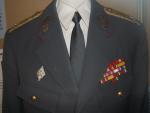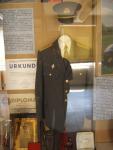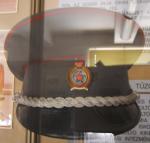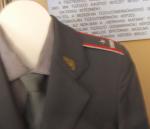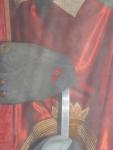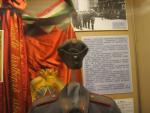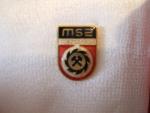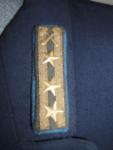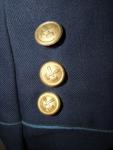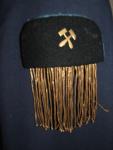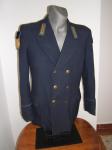-
Posts
4,721 -
Joined
-
Last visited
-
Days Won
7
Content Type
Profiles
Forums
Blogs
Gallery
Events
Store
Everything posted by Gordon Craig
-
Charles and I had an opportunity to visit the Firefighter Museum here in Budapest on Wenesday the 28th of March. A very interesting place filled with lots of uniforms, medals, photos etc dealing for fire prevention etc from Roman times up to current stuff. Not a place many people visit but for anyone interested in collecting Hungarian uniforms or medals it is well worth a visit. We spent just under two hours there and I can see at least one more, and possibly two, visits in the near future. Because almost all of the displays that we took picutres of was behind glass some of the pictures didn't turn out at all and others a fuzzy. Please excuse the fuzzy photos but even then there is lots of interest to see. In the uniform picture I posted to start this thread the collar devices are crossed fireman's tools. In some of the photos I'll post today the collar insignia is of a fire truck. According to the guy at the museum, the crossed tools meant people involved in fire prevention while the truck indicates guys who actually fight the fires. I am not sure this is actually the case as all of the English text material we picked up at the mueuam talks about "fire prevention" only even when they are referring to actually fighting fires. I am going to start with a uniform from the Rakoci period which is earlier than the one I started this thread with.
-
Chris, Very nice and thanks for posting them. It looks as though the bronze one is in an earlier wooden case and the gold one in plastic case. True? Do the cases have a design showing the badge on the outside of the top? Regards, Gordon
-

Hungary Hungarian Miners Uniform
Gordon Craig replied to Gordon Craig's topic in Central & Eastern European States
Zsolt, Thanks. My mistake. Thanks for correcting it. Regards, Gordon A correct set of miners medals. -
Grant, Considering the award was instituted on 22.02.58 and this particular style of medal with the 28mm banspange was only awarded in 1958 I would say that is a fair comment. No idea how many were awarded but it had to be a small number. It takes a while for a new award to get into production and then to be awarded. For someone to be awarded this medal, I would imagine they would need to prove that they qualified for it. That also would take time. Considering this, I would say "rare" would be a good choice of words. Regards, Gordon
-

Hungary Hungarian Miners Uniform
Gordon Craig replied to Gordon Craig's topic in Central & Eastern European States
The bronze medal came with a T?RZSG?RDA pin stuck into the lid. For more info on these pins see my thread about them. -

Hungary Hungarian Miners Uniform
Gordon Craig replied to Gordon Craig's topic in Central & Eastern European States
-

Hungary Hungarian Miners Uniform
Gordon Craig replied to Gordon Craig's topic in Central & Eastern European States
The Miner's medals, from leaft to right, Bronze, Silver and Gold. The gold one is not in the correct case. This case is a strange colour because it was quite moldy when I got it and didn't clean up that well. See Decker's post for the award documents and other interesting facts. PICTURE REMOVED BY GORDON. -

Hungary Hungarian Miners Uniform
Gordon Craig replied to Gordon Craig's topic in Central & Eastern European States
-

Hungary Hungarian Miners Uniform
Gordon Craig replied to Gordon Craig's topic in Central & Eastern European States
-

Hungary Hungarian Miners Uniform
Gordon Craig replied to Gordon Craig's topic in Central & Eastern European States
-
Gents, Yesterday Charles and I visited the Fireman's Museum and had a very interesting time but that is the subject for another thread. After we left the museum there was still enough time to visit Ecseri Flea Market. We both picked up some items for our collection and I just happened to luck onto a Hungarain Miner's blue tunic. Charles and I had both seen a tunic like this in a family photo, which I thought I had in my archives but can not find right now, but had no idea what it was. Once we saw it in the flesh it was obvious. The tunic is double breasted and has a double row of three brass buttons on the front. Each button has the crossed miners hammers so common in Europe. There are also three identical, although smaller, buttons on each sleeve cuff. On each arm is a black cloth sort of half circel device trimmed in light blue with a gold fringe hanging from it. In the centre of each of these sleeve attachments are brass, cross hammers. The hammers on the right sleeve are broken. On each collar are grey collar tabs, trimmed in light blue, with three gold stars resting on two rows of gold tress, and above that brass, crossed hammers. The hammers on the right collar tab are broken. The sleeve cuffs are trimmed in the same light blue as the other acountremonts. There is a pocket in each tunic skirt closed with a flap but no button. The tunic is lined with a linen type material in the same colour as the tunic. There is one interior pocket in the left breast. The sleeve are a plain off white cotton type material. There are no stamps in the tunic. There was once a tailors label at the neck but there is only a tiny scrap of this left and there is no information obtainable from it. There is one ribbom bar loop on the tunicbut the other one is no longer present. The tnic is very dirty and has several small holes, some where the ribbon bar would have gone, and signs of something being pinned on the lef tbreast at some time but there is no way of knowing what at this point. It is common among European miner's uniforms for the trim colour to identify some specific type of work. There is an article on the web about The Academy of Selmec, Hungary. It says that mining was the first profession and devotes a section to uniforms. These colours will not necessarily be accurate for today but will serve to illustrate some colour combinations of the past. Because this school was operational during the period of the Austro-Hungarian Empire their uniforms reflect the Germanic tradition and were black. There colour combinations were; metal workers: black with claret velvet mechanics: black with blue velvet organizers: blue with blue velvet teachers of technical subjects: black with brown velvet For comparison puposes, the DDR miner's only used two colours; Miners: black velvet with blue trim Administrative personnel: black velvet with yellow trim The Oroszl?ny Miner?s Museum (B?ny?sz M?zeum) is located close to Tatabanya, about an hours drive from Budapest. Decker lives in the area and his family appears to have had a long association with mining in that area. Perhaps he can add some more to this thread. You can also find related info on his thread on Miner's Medals. Here sre some pictures of the Hungarian Miners tunic which probably dates for the Communist period.
-

Hungary Mining Service Medal
Gordon Craig replied to decker's topic in Central & Eastern European States
Chris, Nice to have you back with us. Thanks for posting pictures of the documents. I will be posting my cased Miner's Medals soon on a thread related to the Miner's uniform. Perhaps you can add some info to that one for us. I have no information on the uniform other than what I can deduce from the tunic that I own. Regards, Gordon -
Charles, I can now post a picture of the sword in wear on this type of belt. It is not an army officer but a police officer on parade. The belt and cross strap are the same. It is from a book we both have "MAYGARORSZG 1945-1960". I can not post a page number as there are none in the book but it is very close to the back of the book. Regards, Gordon
-
Ulsterman, In the book Richard S refers to it says there are Gold, Silver and Bronze classes to this award. I have seen a number of silver ones in Flea Markets but don't remember seeing any other grades. I'll have to look this weekend. Regards, Gordon
-

DDR East German Forestry Service Uniforms
Gordon Craig replied to Gordon Craig's topic in Germany: Post 1945: Bundesrepublik & DDR





